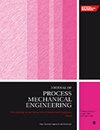指数伸长多孔板引起的 MHD 生物对流威廉森-麦克斯韦纳米液流的数值探索
IF 2.2
4区 工程技术
Q2 ENGINEERING, MECHANICAL
Proceedings of the Institution of Mechanical Engineers, Part E: Journal of Process Mechanical Engineering
Pub Date : 2024-09-10
DOI:10.1177/09544089241279689
引用次数: 0
摘要
这项研究深入探讨了非牛顿流体与微生物结合的有趣领域,提出了一个数学模型,专门用于分析寄生有回转微生物的威廉森-麦克斯韦纳米流体内部的传热和传质。该研究探讨了这些流体在磁场、热辐射、化学反应和耗散效应等多种因素影响下的行为方式。利用一组相似性不变式,将控制方程转化为常微分方程,然后使用四阶 R-K 方案进行求解。研究结果以图表形式呈现,深入揭示了各种流动参数,并辅以相关的物理解释。图中显示了磁通量([公式:见正文])、浮力比([公式:见正文])、佩克莱特数([公式:见正文])和施密特数([公式:见正文])对各种物理参数的影响。值得注意的是,研究表明,虽然增加外部磁场会阻碍流体运动,但会增强热层和密度层。此外,较高的生物对流施密特数会降低微生物密度。这些观察结果对涉及纳米流体和微生物的生物医学、制药、生物燃料和其他领域的应用具有重要意义。总之,这项研究为了解复杂流体系统在不同工业环境中的潜在应用贡献了宝贵的知识。本文章由计算机程序翻译,如有差异,请以英文原文为准。
Numerical exploration of MHD bioconvective Williamson-Maxwell nanoliquid flow due to an exponentially elongated porous sheet
This research delves into the intriguing realm of non-Newtonian fluids in conjunction with microorganisms, presenting a mathematical model tailored to analyze heat and mass transfer within Williamson-Maxwell nanofluids hosting gyrotactic microbes. The study investigates how these fluids behave under the influence of multiple factors such as magnetic fields, thermal radiation, chemical reactions, and dissipation effects. Employing a set of similarity invariants, the governing equations are transformed into ordinary differential equations, which are then solved using a fourth-order R-K scheme. The findings, presented graphically, offer insights into various flow parameters and are complemented by pertinent physical explanations. The influence of magnetic flux ([Formula: see text]), Buoyancy ratio ([Formula: see text]), Peclet number ([Formula: see text]), and Schmidt number ([Formula: see text]) on various physical parameters are shown graphically. Notably, the research reveals that while increasing the external magnetic field impedes fluid motion, it enhances thermal and density layers. Additionally, a higher bioconvective Schmidt number is shown to reduce microbial density. These observations hold significant implications for applications involving nanofluids and microorganisms across biomedical, pharmaceutical, biofuels, and other sectors. Overall, this study contributes valuable knowledge to the understanding and potential utilization of complex fluid systems in diverse industrial contexts.
求助全文
通过发布文献求助,成功后即可免费获取论文全文。
去求助
来源期刊
CiteScore
3.80
自引率
16.70%
发文量
370
审稿时长
6 months
期刊介绍:
The Journal of Process Mechanical Engineering publishes high-quality, peer-reviewed papers covering a broad area of mechanical engineering activities associated with the design and operation of process equipment.

 求助内容:
求助内容: 应助结果提醒方式:
应助结果提醒方式:


